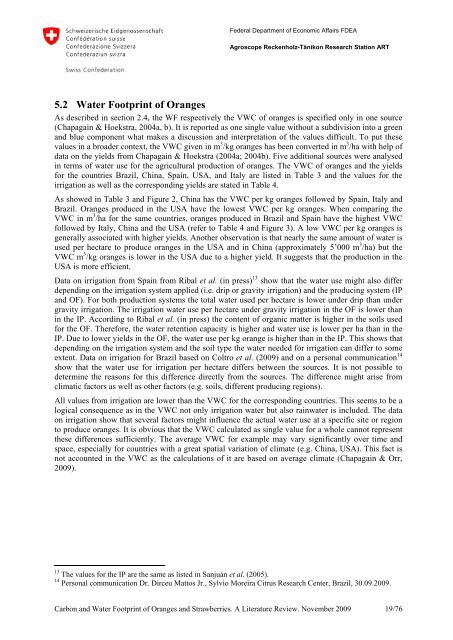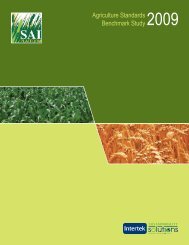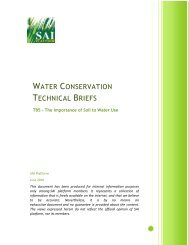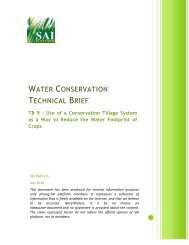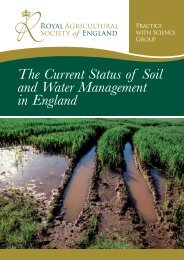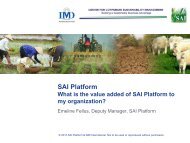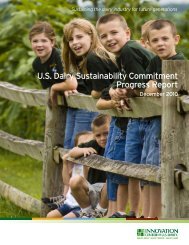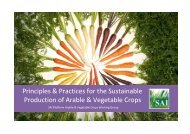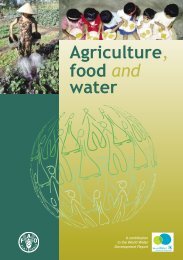Carbon & Water Footprint of Oranges and Strawberries - SAI Platform
Carbon & Water Footprint of Oranges and Strawberries - SAI Platform
Carbon & Water Footprint of Oranges and Strawberries - SAI Platform
Create successful ePaper yourself
Turn your PDF publications into a flip-book with our unique Google optimized e-Paper software.
Federal Department <strong>of</strong> Economic Affairs FDEA<br />
Agroscope Reckenholz-Tänikon Research Station AR T<br />
5.2 <strong>Water</strong> <strong>Footprint</strong> <strong>of</strong> <strong>Oranges</strong><br />
As described in section 2.4, the WF respectively the VWC <strong>of</strong> oranges is specified only in one source<br />
(Chapagain & Hoekstra, 2004a, b). It is reported as one single value without a subdivision into a green<br />
<strong>and</strong> blue component what makes a discussion <strong>and</strong> interpretation <strong>of</strong> the values difficult. To put these<br />
values in a broader context, the VWC given in m 3 /kg oranges has been converted in m 3 /ha with help <strong>of</strong><br />
data on the yields from Chapagain & Hoekstra (2004a; 2004b). Five additional sources were analysed<br />
in terms <strong>of</strong> water use for the agricultural production <strong>of</strong> oranges. The VWC <strong>of</strong> oranges <strong>and</strong> the yields<br />
for the countries Brazil, China, Spain, USA, <strong>and</strong> Italy are listed in Table 3 <strong>and</strong> the values for the<br />
irrigation as well as the corresponding yields are stated in Table 4.<br />
As showed in Table 3 <strong>and</strong> Figure 2, China has the VWC per kg oranges followed by Spain, Italy <strong>and</strong><br />
Brazil. <strong>Oranges</strong> produced in the USA have the lowest VWC per kg oranges. When comparing the<br />
VWC in m 3 /ha for the same countries, oranges produced in Brazil <strong>and</strong> Spain have the highest VWC<br />
followed by Italy, China <strong>and</strong> the USA (refer to Table 4 <strong>and</strong> Figure 3). A low VWC per kg oranges is<br />
generally associated with higher yields. Another observation is that nearly the same amount <strong>of</strong> water is<br />
used per hectare to produce oranges in the USA <strong>and</strong> in China (approximately 5’000 m 3 /ha) but the<br />
VWC m 3 /kg oranges is lower in the USA due to a higher yield. It suggests that the production in the<br />
USA is more efficient.<br />
Data on irrigation from Spain from Ribal et al. (in press) 13 show that the water use might also differ<br />
depending on the irrigation system applied (i.e. drip or gravity irrigation) <strong>and</strong> the producing system (IP<br />
<strong>and</strong> OF). For both production systems the total water used per hectare is lower under drip than under<br />
gravity irrigation. The irrigation water use per hectare under gravity irrigation in the OF is lower than<br />
in the IP. According to Ribal et al. (in press) the content <strong>of</strong> organic matter is higher in the soils used<br />
for the OF. Therefore, the water retention capacity is higher <strong>and</strong> water use is lower per ha than in the<br />
IP. Due to lower yields in the OF, the water use per kg orange is higher than in the IP. This shows that<br />
depending on the irrigation system <strong>and</strong> the soil type the water needed for irrigation can differ to some<br />
extent. Data on irrigation for Brazil based on Coltro et al. (2009) <strong>and</strong> on a personal communication 14<br />
show that the water use for irrigation per hectare differs between the sources. It is not possible to<br />
determine the reasons for this difference directly from the sources. The difference might arise from<br />
climatic factors as well as other factors (e.g. soils, different producing regions).<br />
All values from irrigation are lower than the VWC for the corresponding countries. This seems to be a<br />
logical consequence as in the VWC not only irrigation water but also rainwater is included. The data<br />
on irrigation show that several factors might influence the actual water use at a specific site or region<br />
to produce oranges. It is obvious that the VWC calculated as single value for a whole cannot represent<br />
these differences sufficiently. The average VWC for example may vary significantly over time <strong>and</strong><br />
space, especially for countries with a great spatial variation <strong>of</strong> climate (e.g. China, USA). This fact is<br />
not accounted in the VWC as the calculations <strong>of</strong> it are based on average climate (Chapagain & Orr,<br />
2009).<br />
13 The values for the IP are the same as listed in Sanjuán et al. (2005).<br />
14 Personal communication Dr. Dirceu Mattos Jr., Sylvio Moreira Citrus Research Center, Brazil, 30.09.2009.<br />
<strong>Carbon</strong> <strong>and</strong> <strong>Water</strong> <strong>Footprint</strong> <strong>of</strong> <strong>Oranges</strong> <strong>and</strong> <strong>Strawberries</strong>. A Literature Review. November 2009 19/76


